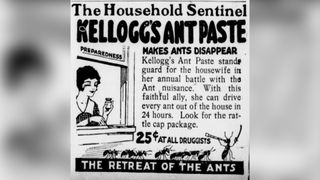
An newspaper ad for Kellogg’s Ant Paste.
(Image credit: San Antonio Express via The Portal to Texas History)
Indiana Jones may say that artifacts belong in museums, but he probably never encountered a whiskey bottle filled with pee or arsenic-laced ant poison.
Now, two scientists are revealing the results of their years spent cataloging “odious materials” from archaeology collections around the U.S. In a study published Oct. 19 in Advances in Archaeological Practice, University of Idaho archaeologist Mark S. Warner and his colleague, chemist Ray von Wandruszka, summarized the 15 years they have spent identifying and testing noxious substances from archaeological artifacts.
Their hunt for the grossest objects lurking in museums began when a large excavation of the 19th-century town of Sandpoint in northern Idaho in 2008 uncovered sealed glass bottles with mysterious contents among the other nearly 600,000 artifacts.
Warner and von Wandruszka teamed up to identify what was inside them. They found examples of creams and ointments, iron tonic, and wood tar in the sealed containers, along with empty bottles labeled “poison”, bullets containing gunpowder, and even a human tooth with a zinc-based filling.
Archaeologists at the site also found a bottle of “Gouraud’s Oriental Cream.” The creamy white substance turned out to be mercurous chloride, also called calomel, which was used throughout the 18th and 19th centuries for everything from preventing acne to treating yellow fever, until doctors realized that mercury was actually quite poisonous.
Advertisement for Dr T Felix Gouraud’s ‘Oriental Cream or Magical Beautifier,’ 1886. The text promises that the product ‘Removes Tan, Pimples, Freckles, Moth Patches, Rash and Skin Diseases and every blemish on beauty, and defies detection. It has stood the test of thirty years, and is so harmless we taste it to be sure the preparation is properly made.’ (Image credit: Stock Montage / Contributor via Getty Images)
From a site in California, the researchers also tested a small jar of ant paste made by Kellogg’s in the early 20th century and found that it still contained arsenic. They also found an ampule of toxic, phosphorus-based rodenticides from an old hospital in New England and aluminum phosphide tablets from a school site in Florida.
Some of the odious objects are toxic; others are just gross.
A sealed bottle of malt whiskey from a historic site in Washington state contained urea — an organic compound found in urine. “The bottle was used as a vessel of convenience, in order to avoid a nighttime trip to the outhouse,” the researchers wrote in their study.
Not knowing exactly what kind of stuff is on the shelves of archaeological collections can be problematic, the researchers noted in the study. “A broken ampule of phosphide or a leaking bottle of 100-year-old urine may only lead to a nasty cleanup job, but it could be much worse,” they wrote.
That’s why archaeological collection managers should identify objects that retain their contents and why field workers should receive training for how to handle potentially toxic substances they might find, the researchers said. Once found, having an analytical chemist test the material is ideal.
Most of the icky substance detective work for this project is done via infrared or atomic absorption spectrometry at the University of Idaho’s chemistry department by undergraduate students majoring in chemistry or biology, von Wandruszka told Live Science in an email. “The project is tremendous training for students,” Warner said.
Trapper cabin oil. (Image credit: R. von Wandruszka)
Warner’s and von Wandruszka’s work “is a great model for other universities and museums to emulate,” Katie Stringer Clary, a specialist in public history and museum studies at Coastal Carolina University who was not involved in the study, told Live Science in an email. “Who knows what other noxious or intriguing items could be uncovered in archaeological collections with further interdisciplinary investigation?”
Warner noted that the team is always on the lookout for new substances to test. “We do this work for free,” Warner said. He cautioned, though, that “people should probably touch base with us beforehand regarding the materials they want to test.” No one wants an ampule of phosphorus to explode in the mail.
Stay up to date on the latest science news by signing up for our Essentials newsletter.
Kristina Killgrove is an archaeologist with specialties in ancient human skeletons and science communication. Her academic research has appeared in numerous scientific journals, while her news stories and essays have been published in venues such as Forbes, Mental Floss and Smithsonian. Kristina earned a doctorate in anthropology from the University of North Carolina at Chapel Hill and also holds bachelor’s and master’s degrees in classical archaeology.
>>> Read full article>>>
Copyright for syndicated content belongs to the linked Source : Live Science – https://www.livescience.com/archaeology/from-arsenic-to-urine-archaeologists-find-artifacts-on-museum-shelves
